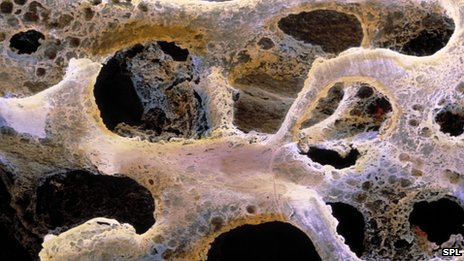A discovery in mice could help to treat people with a form of brittle bone disease, scientists said.
In an American study, mice were bred with osteogenesis imperfecta (OI) and the activity of a protein which shapes and reshapes bones was monitored. Scientists said intense activity of the protein in the mice was linked to OI.
They said the finding could lead to a new target for treatment, but experts warn the study is in mice and might not apply to humans.
Human trials?
One in 15,000 people in the UK are estimated to have osteogenesis imperfecta (OI). It is an inherited condition, where abnormalities in the genes controlling collagen affect the bone’s strength.
In severe cases, people with OI can have between 200 and 300 fractures by the time they reach age 18, the Brittle Bone Society said. Current treatment is lacking.
Scientists at the Baylor College of Medicine, University of Texas, looked at a protein in mice bred with the condition and compared them to “normal” mice.
They said the activity of transforming growth factor beta (TGF), which co-ordinates the shaping and reshaping of bone, was excessive in mice with OI.
When TGF was blocked with an antibody, the mice’s bones withstood “higher maximum load and ultimate strength” and showed “improved whole bone and tissue strength”, suggesting “resistance to fracture”, the study said.
Research was published in the journal Nature Medicine.
Dr Brendan Lee, professor of molecular and human genetics at Baylor College of Medicine, said the study could “move quite quickly” into humans, and be at a clinical trial stage later this year, or early next year.
‘Open doors’
A pharmaceutical company in the US was looking at the pathway of TGF in other diseases, such as kidney disease, which could accelerate the trials, he said. One mechanism behind the findings could be that the disruption of TGF meant the bone was absorbed in the body more quickly than it was made.
Dr Lee added: “We now have a deeper understanding for how genetic mutations that affect collagen and collagen processing enzymes cause weak bones.”
He said the treatment appeared “even more effective” than other existing approaches.
Prof Nick Bishop, is professor at the University of Sheffield and chairman of the Brittle Bone Society’s medical advisory board. He said the study was a “paradigm shifter” as it exposed a possible new target for treatment.
But Prof Bishop said: “This is another mouse study with potential to transfer to humans, we hope, but remember mice are not human.”
He added: “Other treatments that have worked really well in mice with brittle bones, like bone marrow transplantation, haven’t worked as well in humans and are not standard practice as of now.”
Dr Claire Bowring, medical policy manager at the National Osteoporosis Society, said the study was “basic science” in mouse models to understand the “basics of bone biology”.
She said: “It could, in the future, help develop knowledge about bone conditions more fully. As we understand more about bone turnover and communication between bone cells, work could open doors for future research that could affect osteoporosis.”
Dr Bowring said it could take 10 to 15 years for such mouse studies to reach the stage of clinical trials in people.
Source: BBC




